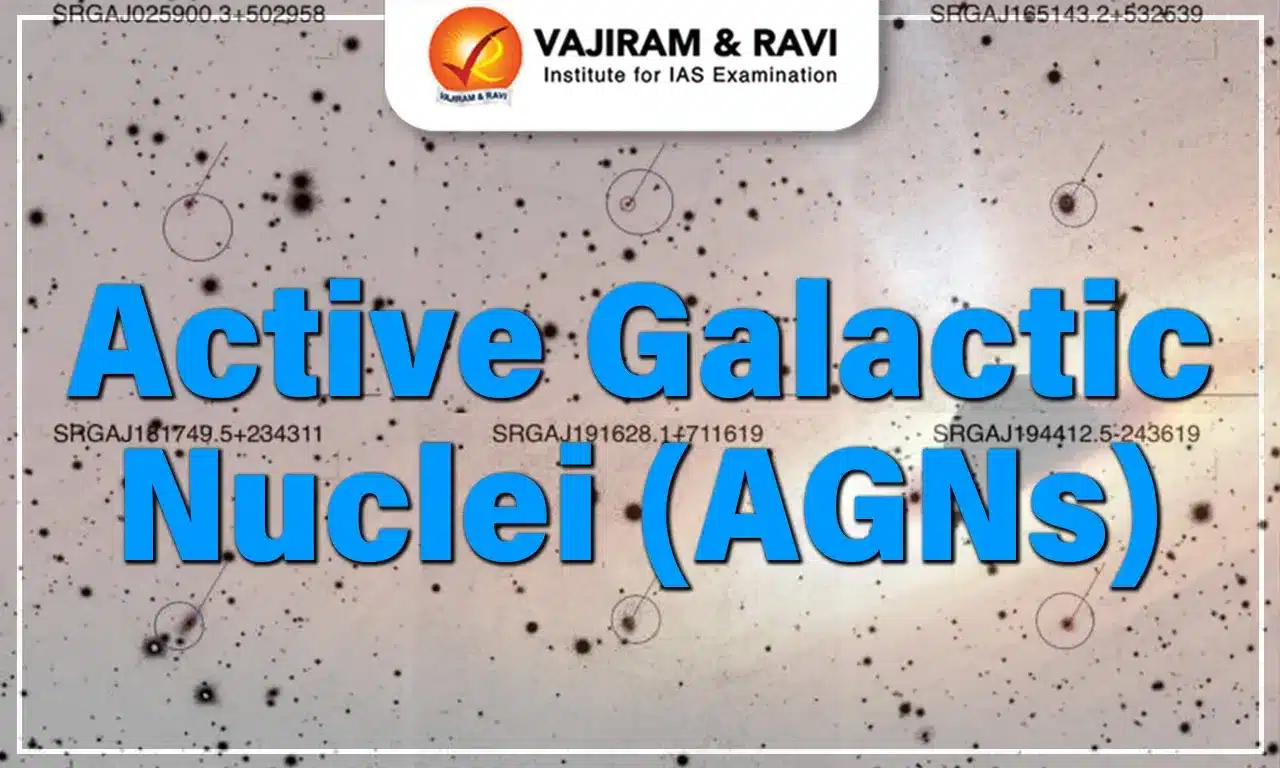Active Galactic Nuclei (AGNs) Latest News
Astronomers from the Russian Academy of Sciences, using the Spektr-RG (SRG) space observatory, have detected 11 new Active Galactic Nuclei (AGNs) during their all-sky X-ray surveys.
What are Active Galactic Nuclei (AGNs)?
- Active Galactic Nuclei (AGNs) are compact regions at the centers of galaxies that emit exceptionally high levels of electromagnetic radiation, often outshining the rest of the galaxy.
- This intense emission arises from either accretion of matter by a supermassive black hole or intense star formation activity.
- AGNs are among the most luminous and persistent energy sources in the universe and are critical to understanding galaxy formation and evolution.
- The newly detected AGNs were identified during an optical and X-ray inspection of sources listed in the ARTSS1-5 catalog, using SRG’s ART-XC telescope.
- The team has also previously identified more than 50 AGNs and several cataclysmic variable stars.
Key Characteristics of the 11 Newly Detected AGNs
- All 11 AGNs are located at redshifts ranging from 0.028 to 0.258, indicating they are relatively nearby in cosmic terms.
- Their X-ray luminosities fall within the typical range of 2 to 300 × 10³⁹ erg/s, which is consistent with known AGN profiles.
Classification into Seyfert Types
- All detected AGNs were classified as Seyfert galaxies, a type of AGN that is common and well-studied:
- 7 galaxies were classified as Seyfert Type 1 (Sy 1), characterized by broad optical emission lines.
- 3 galaxies were classified as Seyfert Type 1.9 (Sy 1.9), showing partially broadened lines.
- 1 galaxy was classified as Seyfert Type 2 (Sy 2), which exhibits narrow emission lines only.
- Seyfert galaxies appear like normal galaxies in visible light but show strong infrared and X-ray emissions due to activity at their cores.
Active Galactic Nuclei (AGNs) FAQs
Q1: What are Active Galactic Nuclei (AGNs)?
Ans: AGNs are extremely bright central regions of some galaxies, powered by supermassive black holes accreting matter.
Q2: Why are AGNs important in astrophysics?
Ans: AGNs help scientists understand galaxy evolution, black hole activity, and cosmic energy sources across the universe.
Q3: What types of AGNs are there?
Ans: Common types include quasars, blazars, Seyfert galaxies, and radio galaxies, each emitting energy across various wavelengths.
Source: PHY
Last updated on December, 2025
→ Check out the latest UPSC Syllabus 2026 here.
→ Join Vajiram & Ravi’s Interview Guidance Programme for expert help to crack your final UPSC stage.
→ UPSC Mains Result 2025 is now out.
→ UPSC Notification 2026 is scheduled to be released on January 14, 2026.
→ UPSC Calendar 2026 is released on 15th May, 2025.
→ The UPSC Vacancy 2025 were released 1129, out of which 979 were for UPSC CSE and remaining 150 are for UPSC IFoS.
→ UPSC Prelims 2026 will be conducted on 24th May, 2026 & UPSC Mains 2026 will be conducted on 21st August 2026.
→ The UPSC Selection Process is of 3 stages-Prelims, Mains and Interview.
→ UPSC Result 2024 is released with latest UPSC Marksheet 2024. Check Now!
→ UPSC Prelims Result 2025 is out now for the CSE held on 25 May 2025.
→ UPSC Toppers List 2024 is released now. Shakti Dubey is UPSC AIR 1 2024 Topper.
→ UPSC Prelims Question Paper 2025 and Unofficial Prelims Answer Key 2025 are available now.
→ UPSC Mains Question Paper 2025 is out for Essay, GS 1, 2, 3 & GS 4.
→ UPSC Mains Indian Language Question Paper 2025 is now out.
→ UPSC Mains Optional Question Paper 2025 is now out.
→ Also check Best IAS Coaching in Delhi
Tags: Active Galactic Nucleus (AGN) prelims pointers upsc prelims current affairs

















